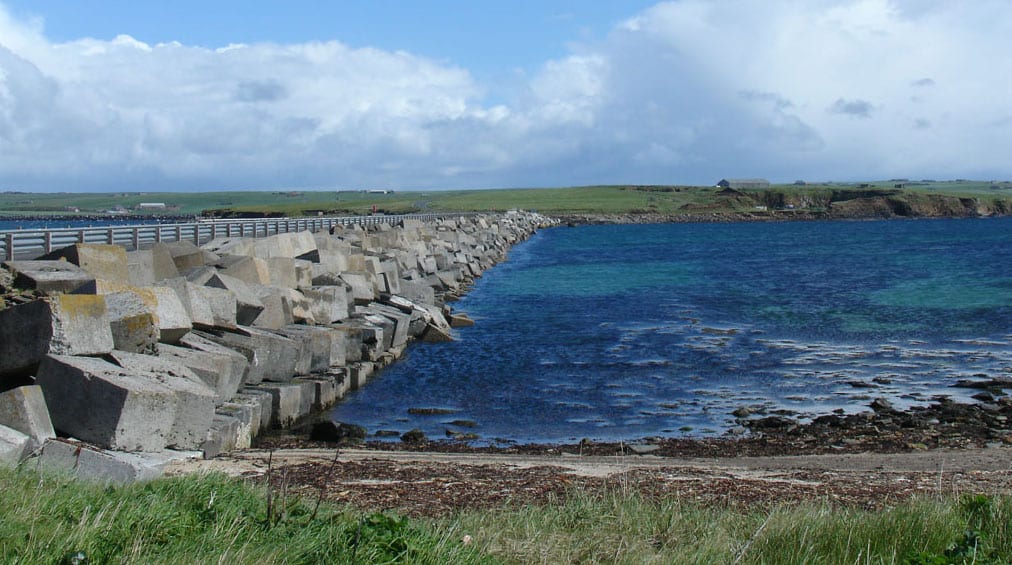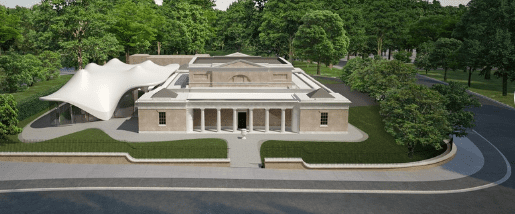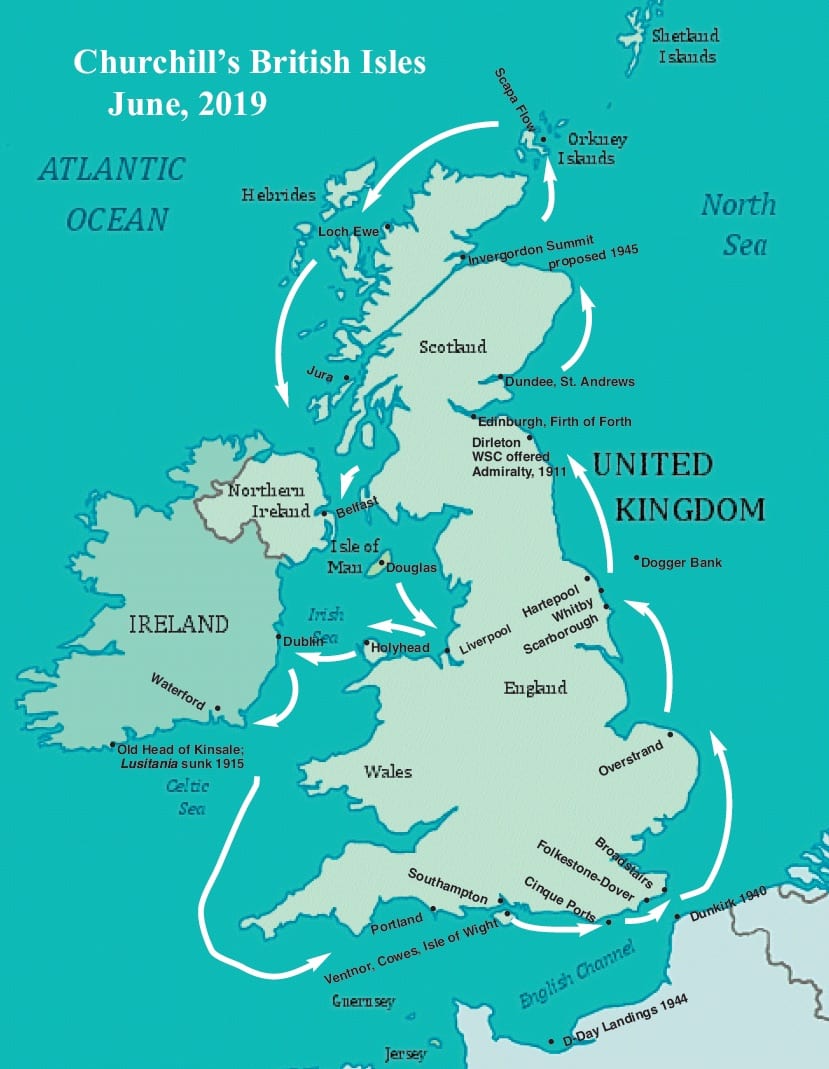
“Churchill’s Britain”: Good Try, But More is Needed
Peter Clark, Churchill’s Britain: From the Antrim Coast to the Isle of Wight. London: Haus Publishing, 2020, 240 pp., no illustrations, $29.95, Amazon $27.48, Kindle $22.49. Excerpted from a review for the Hillsdale College Churchill Project. To read the original, click here.
N.B. March 2021: The original post contains author Clark’s response, which is about the most cordial reply to a grumpy review I’ve ever read. He kindly takes heed of my criticisms and says he will attend to them in the paperback in due course. RML
Churchill’s Britain abridged
I did want to like this book. Having hosted ten tours of Churchill’s Britain, we’ve long hoped for a comprehensive travel guide to all the places in what Lady Soames called “The Saga.” But some improvements are needed to this one, to make it truly helpful.
The first thing one notices is: no photos. How can a book discuss Churchill’s Britain without depicting it? There is no admission information on places open to the public. The index is unhelpful. It lists names but not venues—not even London or Chartwell. To find, say, Ditchley, you have to know it’s in Oxfordshire. (Its map location is buried in the gutter—the maps are double-page spreads.) When you do get to what you want, you find that coverage is often sparse. Woodstock is there for Blenheim Palace; but nothing about its famous haunt the Bear Hotel, or Lord Randolph Churchill’s constituency, which drew young Winston’s close interest.
Churchill’s Britain says the West Country holds few places of interest. Yet a 1996 Churchill tour spent four days there, visiting places associated with Marlboroughs and Churchills. They included Round Chimneys, birthplace of the first Sir Winston; Little Churchill Farm, where the family had its earliest beginnings; Great Trill, birthplace of the First Duke of Marlborough; Ashe House, where Sir Winston thought the Duke was born; and other private homes and churches. Churchill’s Britain does mention Plymouth and Bristol University. Portland gets half a page, but omits the drama of Churchill sending the King’s ships to sea before the 1914 war.
Churchill’s London

London, to which Churchill’s Britain devotes 100 pages, receives good coverage but many omissions. I couldn’t find the Albert Hall or Guildhall, though lesser speech sites are included. In Hyde Park, we find nothing on the old London Magazine (right).
The two London chapters are organized by postal code: SW1 and “everything else.” So to find Winston’s nanny’s grave, you must know the City of London Cemetery is in NW12. From his office at Ministry of Munitions (Hotel Métropole), Churchill gazed with ominous thoughts on Armistice Day 1918. Where is it in Churchill’s Britain? You’ll find it if you can find “Northumberland Avenue” (not in the index).
Clubs and Eateries
Here too is the National Liberal Club (actually on Whitehall Place), celebrated haunt of the young Winston. A more precise account of this and nearby venues is on Hillsdale’s walking tour of Churchill’s Whitehall. The book omits most of Sir Winston’s clubs: Boodles, Bucks, the Reform, the Athenaeum. I could not find the Savoy Hotel’s Pinafore Room, home of The Other Club.
Whitehall is well covered, but omits the former Carlton Hotel (now New Zealand House), where WSC dined on the eve of war in 1914, and Ho Chi Minh cooked his vegetables. Included is the Foreign Office, where he didn’t serve, but not the Colonial Office, where he did. To its credit, Churchill’s Britain contains most of WSC’s residences (so long as you know the postal code), missing only four or five.
Round the Island
The 2019 Hillsdale College cruise circumnavigated Churchill’s Britain, passing or visiting many historic locations. The book omits several key ones. In Broadstairs, Kent, young Marigold Churchill died and WSC observed the planning for D-Day. Hartlepool, Whitby and Scarborough, Yorkshire were shelled by the Germans 1914, causing Churchill’s violent reaction. All go unmentioned.
Creditably Churchill’s Britain addresses all four of Churchill’s Parliamentary constituencies: Oldham, Manchester North West, Dundee and Epping/Woodford. But the discussion of Woodford (1945-64) mainly involves its underwhelming statue of him, not his long career there. The book misses St. Margaret’s Bay, near Dover, where a fine Nemon statue broods over the Channel. Statues are not the book’s forte, and are unindexed. Fortunately, there are good books on Churchill as MP for Dundee and Woodford.
Scotland
The Scottish coverage is somewhat uneven. Dirleton, East Lothian, an Asquith residence where Churchill was offered the Admiralty, goes unmentioned. Nevertheless there’s room for a mythical, story involving another Asquith abode, Slains Castle. Here, we are told, Violet Asquith nearly died of grief when she heard that Winston was going to marry that “ornamental sideboard,” Clementine Hozier. Peter Clark doesn’t, however, fall for the canard that the despairing Violet tried to throw herself from the cliffs.
Clementine’s ancestral home, Airlie Castle, is omitted, and other Scottish connections. A book more about people than places should include WSC’s friend Molly, Duchess of Buccleuch, who once informed him that Chamberlain was coming to speak. “It doesn’t matter where you put [his podium],” Churchill advised her, “as long as he has the sun in his eyes and the wind in his teeth.”
Edinburgh needs more attention for Churchill’s early drive for devolution (long before it was fashionable); his visits to Scottish statesmen; the German Fleet surrender in 1919; his Freedom of the City in 1946. In Dundee, the story turns mainly on how he was pushed out of office by a Prohibitionist in 1922—never mind that he won five previous elections, one joyfully described by Luigi Barzini. Scapa Flow in the Orkneys is barely mentioned, with nothing about the tragic sinking of HMS Royal Oak, and how the Churchill Barriers prevented further attacks.
Still room for more
Martin Gilbert, on our second Churchill Tour, spoke of “Churchill’s London,” a lecture happily still online. Stefan Buczacki, in the Churchill Companion, admirably listed all of Churchill’s residences, owned, leased and borrowed. Sir Martin had long wanted to publish a book entitled, Churchill’s London in Maps and Photographs. Alas he didn’t have the time, and a truly comprehensive guide to Churchill’s Britain remains to be written. Peter Clark has opened the case for one, and may yet be heard from again.






